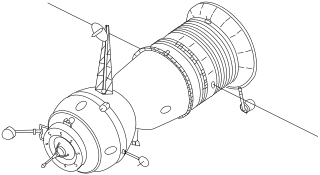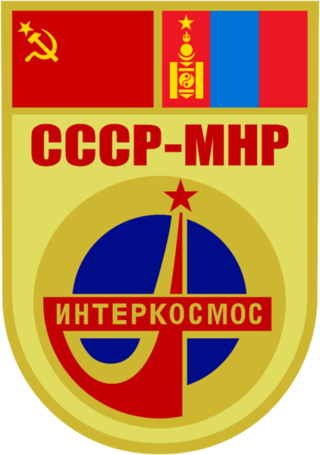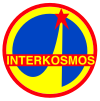
The Salyut programme was the first space station programme, undertaken by the Soviet Union. It involved a series of four crewed scientific research space stations and two crewed military reconnaissance space stations over a period of 15 years, from 1971 to 1986. Two other Salyut launches failed. In one respect, Salyut had the space-race task of carrying out long-term research into the problems of living in space and a variety of astronomical, biological and Earth-resources experiments, and on the other hand, the USSR used this civilian programme as a cover for the highly secretive military Almaz stations, which flew under the Salyut designation. Salyut 1, the first station in the program, became the world's first crewed space station.

Viktor Vasilyevich Gorbatko was a Soviet cosmonaut who flew on the Soyuz 7, Soyuz 24, and Soyuz 37 missions.

Soyuz 9 was a June, 1970, Soviet crewed space flight. The two-man crew of Andriyan Nikolayev and Vitaly Sevastyanov broke the five-year-old space endurance record held by Gemini 7, with their nearly 18-day flight. The mission paved the way for the Salyut space station missions, investigating the effects of long-term weightlessness on crew, and evaluating the work that the cosmonauts could do in orbit, individually and as a team. It was also the last flight of the first-generation Soyuz 7K-OK spacecraft, as well as the first crewed space launch to be conducted at night. In 1970, Soyuz 9 marks the longest crewed flight by a solo spacecraft.

Salyut 5, also known as OPS-3, was a Soviet space station. Launched in 1976 as part of the Salyut programme, it was the third and last Almaz space station to be launched for the Soviet military. Two Soyuz missions visited the station, each crewed by two cosmonauts. A third Soyuz mission attempted to visit the station, but failed to dock, whilst a fourth mission was planned but never launched.

Salyut 6 was a Soviet orbital space station, the eighth station of the Salyut programme, and alternatively known DOS-5 as it was the fifth of the Durable Orbital Station series of civilian space stations. It was launched on 29 September 1977 by a Proton rocket. Salyut 6 was the first space station to receive large numbers of crewed and uncrewed spacecraft for human habitation, crew transfer, international participation and resupply, establishing precedents for station life and operations which were enhanced on Mir and the International Space Station.

Salyut 7, also known as DOS-6 was a space station in low Earth orbit from April 1982 to February 1991. It was first crewed in May 1982 with two crew via Soyuz T-5, and last visited in June 1986, by Soyuz T-15. Various crew and modules were used over its lifetime, including 12 crewed and 15 uncrewed launches in total. Supporting spacecraft included the Soyuz T, Progress, and TKS spacecraft.

Soyuz 29 was a 1978 crewed Soviet space mission to the Salyut 6 space station. It was the fifth mission, the fourth successful docking, and the second long-duration crew for the orbiting station. Commander Vladimir Kovalyonok and flight engineer Aleksandr Ivanchenkov established a new space-endurance record of 139 days.

Soyuz 24 was a February, 1977, Soviet mission to the Salyut 5 space station, the third and final mission to the station, the last purely military crew for the Soviets and the final mission to a military Salyut. The cosmonauts Viktor Gorbatko and Yuri Glazkov re-activated the station after toxic fumes had apparently terminated the mission of Soyuz 21, the previous crew.

Phạm Tuân is a retired Vietnamese Air Force fighter pilot and cosmonaut. He became the first Vietnamese cosmonaut, and the first person of Asian origin to be in space when he launched aboard the Soyuz 37 mission as an Interkosmos research cosmonaut. He was awarded the title Hero of the Soviet Union.

Soyuz 31 was a 1978 Soviet crewed space flight to the Salyut 6 space station. It was the seventh mission to and sixth successful docking at the orbiting facility. The Soyuz 31 crew were the second to visit the long-duration Soyuz 29 resident crew.

Soyuz 33 was an April, 1979, Soviet crewed space flight to the Salyut 6 space station. It was the ninth mission to the orbiting facility, but an engine failure forced the mission to be aborted, and the crew had to return to Earth before docking with the station. It was the first failure of a Soyuz engine during orbital operations.

Soyuz 35 was a 1980 Soviet crewed space flight to the Salyut 6 space station. It was the 10th mission to and eighth successful docking at the orbiting facility. The Soyuz 35 crew were the fourth long-duration crew to man the space station.

Soyuz 36 was a 1980 Soviet crewed space flight to the Salyut 6 space station. It was the 11th mission to and ninth successful docking at the orbiting facility. The Soyuz 36 crew were the first to visit the long-duration Soyuz 35 resident crew.

Soyuz T-2 was a 1980 Soviet crewed space flight to the Salyut 6 space station. It was the 12th mission to and 10th successful docking at the orbiting facility. The Soyuz T-2 crew were the second to visit the long-duration Soyuz 35 resident crew.

Soyuz T-3 was a Soviet spaceflight, launched on 27 November 1980 to the Salyut 6 space station. It was the first Soyuz spacecraft to carry three cosmonauts following the fatal Soyuz 11 disaster in 1971.
Soyuz T-4 was a Soviet space mission which launched the crew of Salyut 6 EO-6, the sixth and final long-duration crew of the Salyut 6 space station. It was launched on 12 March 1981 and docked with the station the next day. During their stay, the EO-6 crew was visited by Soyuz 39 and Soyuz 40. Soyuz T-4 returned to Earth on 26 May 1981; its crew were the last to have inhabited Salyut 6.

Soyuz 39 was a 1981 Soviet crewed space flight to the Salyut 6 space station. It was the fifteenth expedition, and carried the eighth international crew to the orbiting facility. The crew visited Vladimir Kovalyonok and Viktor Savinykh, who had reached Salyut-6 ten days prior.
Soyuz T-7 was the third Soviet space mission to the Salyut 7 space station. Crew member Svetlana Savitskaya was the first woman in space in almost twenty years, since Valentina Tereshkova who flew in 1963 on Vostok 6.

Soyuz T-12 was the seventh crewed spaceflight to the Soviet space station Salyut 7. The name "Soyuz T-12" is also the name of the spacecraft used to launch and land the mission's three-person crew. The mission occurred in July 1984, during the long-duration expedition Salyut 7 EO-3. During the mission, crew member Svetlana Savitskaya became the first woman to ever perform a spacewalk, and the potential Buran space shuttle pilot, Igor Volk, was given spaceflight experience. Unlike many Soyuz visiting missions, the Soyuz lifeboats were not swapped, and the crew returned to Earth in the same spacecraft in which they launched.
Salyut 6 EO-1 was a Soviet long duration space expedition, the first to dock successfully with the space station Salyut 6. The two person crew stayed were in space for a record setting 96 days, from December 1977 to March 1978. The expedition was the start of what would be the semi-permanent occupation of space by the Soviets.


















